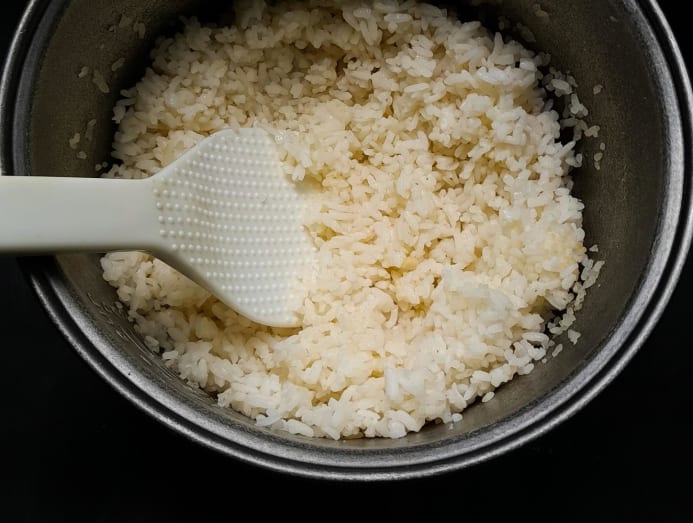How to safeguard yourself from food poisoning: Raw shellfish and fish, runny eggs, leftover rice
It isn’t fried rice paradise anymore if you’re doubled over with severe abdominal pain and diarrhoea from eating last night's leftover rice. Find out how to safeguard yourself if you can't resist raw or barely cooked food such as sashimi, oysters and soft-boiled eggs.

(Photo: iStock/petesphotography and VYCHEGZHANINA)

This audio is generated by an AI tool.
If reading those reports on Port Dickson’s tainted mussels had you thinking about your last food poisoning incident, we don’t blame you. We do, after all, tempt fate on a regular basis by ordering salmon sashimi, which by virtue of its rawness, could come with a side of parasites.
We slurp up jiggly, soft-boiled eggs with lashings of soy sauce, shakes of pepper – and likely, a smidge of salmonella. The practical Asian in us wouldn’t throw out leftover rice – which could potentially have Bacillus cereus spores.
We love our carbs, eggs and seafood a certain way – essentially recooked into another guise, or very under-cooked or not at all. But surely, wouldn't you rather slave over the stove than be enslaved to the toilet bowl?
The key to avoiding food poisoning is “by way of proper preparation, cooking and storage”, said Dr Shawn Vasoo, the clinical director of National Centre for Infectious Diseases.
And it’s not only food poisoning that we should be concerned with. While antibiotics are not routinely needed to treat food poisoning as it is usually self-limiting, they have their hero moments when the diarrhoea is prolonged, he said. Antibiotics may also be needed if the bacterial infection has invaded the bloodstream or caused inflammation in the intestinal tract.

But there’s a problem. “Worldwide, antibiotic resistance in bacteria has been a growing problem,” said Dr Vasoo. “For example, there are reports of salmonella that are resistant to particular classes of antibiotics such as ciprofloxacin.” The resistance is “partially due to the use of antibiotics in farming”.
By the way, you should seek medical attention if the symptoms are severe, such as more than six diarrhoea episodes in 24 hours, fever, blood in the bowels, severe abdominal pain and/or dehydration from an inability to take fluids, said Dr Vasoo.
So, what can you do if a plate of almost-raw see hum with a side of chilli sauce and lime juice warm the cockles of your heart – and you can’t resist them? If you’re concerned, here’s a look at how you can safeguard yourself from ordering or cooking up a side of food poisoning with your favourite dishes.
SHELLFISH

If you’re going raw or even part raw, there’s a chance you’ll encounter some nasties with shellfish. That’s because these creatures eat by filtering water and in doing so, they accumulate bacteria, viruses and toxins from their environment – such as the harmful algae and biotoxins that have recently proliferated in Port Dickson’s waters, owing to the hot weather.
Contaminated mussels may be making the headlines but the biggest threats are actually oysters as they are almost always consumed raw, according to the Singapore Food Agency (SFA). “As such, all imports of live oysters must be from SFA-approved sources and accompanied with a health certificate to ensure food safety,” noted its website. “Upon arrival, imported food is subject to our food safety surveillance programme, which includes inspection, sampling, and testing.”
What you can do: If you remember reading about families digging up the sand at Changi Beach at low tide and thinking, maybe foraging for a bit of clams isn’t a bad idea, don't do it. The shellfish you bring home may contain biotoxins that cannot be removed or destroyed by cooking. Plus, you don’t want to get on the wrong side of the law for taking what you shouldn’t.
A much safer way is buy shellfish from SFA-approved businesses. For oyster-on-the-half-shell aficionados, only eat those that are labelled or designated as ready-to-eat. And while nothing beats the briny, mineral-y sweetness of a slurped oyster, the singular life-preserving thing you can do is to cook your molluscs. Even parboiled gong gong (sea snails) or la la (clams) can be sus as pollutants such as biotoxins cannot be destroyed by heat.
The SFA also suggests coming around to the idea of golden, batter-fried oysters (fried at 190 degrees Celsius for at least three minutes) or garlic-baked ones (baked at 232 degrees Celsius for at least 10 minutes). For other shellfish, boil until the shells open and continue boiling for at least another three to five minutes, or steam for at least four to nine minutes.
RAW FISH

Remember the wriggly additions found in a couple’s sashimi bowls about a year ago? When it comes to seafood, especially raw ones, there is always a risk of anisakiasis or herring worm disease caused by eating infected fish or squid. Roundworms, which are commonly found in marine fish as they are a main food source for them, are another concern. Like shellfish, raw fish can also contain a higher germ count if good hygiene is not practised.
The SFA does test ready-to-eat raw fish for a wide range of food-borne hazards, including microbial pathogens and parasites, to keep them off our favourite salmon or maguro sashimi. You can do your part, too, by asking whether the fish was sourced from importers that adopt proper cold chain management, said the SFA.
What you can do: Buy ready-to-eat raw fish from licensed establishments – and eat only those designated for raw consumption if you don’t intend to cook it. How you store your cuts of tuna or salmon is also important: In the chiller at temperatures between 0 degrees Celsius and 4 degrees Celsius soon after purchase, said the SFA.
“When in doubt, cook the fish thoroughly before consumption as cooking is an effective way to kill bacteria and parasites.”
SOFT-BOILED EGGS

Not everyone enjoys their morning eggs the way we do. It was evident in the comments on a US-based vlogger’s post about the classic Singaporean breakfast of kaya toast and soft-boiled eggs. “Explosive diarrhoea”, “disgusting” and “snotty” were some of the words used by international netizens to describe the eggs.
They do have a point in that salmonella is a very real problem in eggs and is a “leading cause of food-borne illnesses worldwide”, according to the SFA. This is why eggs in other countries are cooked thoroughly before eating.
In order for you to enjoy onsen and poached eggs with ease of mind, the SFA ensures that imported eggs come from “approved sources in accredited countries and regions that meet Singapore’s food safety and animal health standards”.
Local egg farms must also demonstrate “good farm management practices and strong biosecurity measures” to prevent salmonella contamination, said the SFA, which means removing soiled and/or cracked eggs, and regularly testing their hens for salmonella. “If salmonella is detected through our tests, the farm will be suspended until the contamination issue is rectified.”
What you can do: Those stringent requirements make it “relatively safe to eat raw or lightly cooked eggs in Singapore”, said the SFA. But there is always a risk with raw food, so if you are pregnant, immunocompromised, very young or elderly, it is best to avoid them.
If you must include raw or lightly cooked eggs in food such as tiramisu, mayonnaise and hollandaise sauce, use pasteurised eggs that have been heat treated to eliminate bacteria. Otherwise, prepare or order eggs that are cooked until the whites and yolks are firm; runny egg whites or yolks may still contain bacteria, said the SFA.
To safeguard yourself further, finish up your eggs as soon as they are cooked. If there are leftovers, refrigerate the eggs or any dish containing eggs promptly (below 4 degrees Celsius) to avoid bacterial growth.
LEFTOVER RICE

Every Asian cook knows that the de facto ingredient for good fried rice is overnight rice – and therein lies the problem. That’s because cooked rice is a hotbed for bacillus cereus, a bacterium that can cause food poisoning. And it’s not just cooked rice; this nasty is also commonly linked to other starchy food such as noodles and pasta, and vegetables via soil as well, according to the SFA.
What's worrying is that bacillus cereus can proliferate at room temperature, said Dr Vasoo. When plain rice is left on the countertop for the whole afternoon before you pop it into the fridge, the harm could already be done. Then, if you allow the cold rice to warm up to room temperature before frying it, you’re encouraging bacillus cereus to proliferate again, he cautioned. And get this: The bacteria produces spores that are resistant to heat, so even reheated fried rice could make you sick.
What you can do: Keep leftover rice out of the temperature danger zone by refrigerating it at 4 degrees Celsius or lower, or hot at 60 degrees Celsius or higher. “By practising good temperature control, we can limit the growth of the bacteria and its spores,” said the SFA. It also pays to make sure the rice you’re refrigerating isn’t contaminated with someone’s saliva or mixed with other sauces or food to avoid cross-contamination.
When prepping vegetables, wash them thoroughly, especially at the roots, to remove soil that may contain bacillus cereus. As for cooking or reheating fried rice, ensure you fry it thoroughly with a temperature of at least 75 degrees Celsius to at least take out the bacteria.






